This is a page within the www.staffshomeguard.co.uk website. To see full contents, go to SITE MAP.
HOME GUARD MEMORIES AND INFORMATION - WARWICKSHIRE, BIRMINGHAM
5th WARWICKSHIRE (SOLIHULL) BATTN.
Lt. G. G.
CATES
and the
Imberdown tragedy of 13th April 1942
(page updated
January 2018) |
Lt. Gerald
George Cates was a member of the
5th
Warwickshire (Solihull) Battalion
under the command of
Lt.-Col. F.
Blennerhassett.
Gerald
Cates was born on 22nd October 1897 in
Portsea, into a military family, the son
of Henry John and Frances W.B. Cates. This
military connection probably explains his
enlistment in the Army in 1913 at the
early age of 15 or 16.
He had a long Great
War career in the
A.S.C. (which later
became the R.A.S.C.) and in the later
years of the war as a
pilot in the R.F.C./R.A.F. In 1924
he married Ruth Pougher of Solihull. By
the outbreak of WW2 he was living with his
family at 5 Winterbourne Road, Solihull
and was employed as
an official in the
Birmingham Inland
Revenue office. |
Lt. CATES and the
HOME GUARD
Gerald Cates's
Great War military experience would have
led to his immediate appointment to a
position of authority as soon as the Home
Guard was formed in May 1940.
All that is so far known about this Home Guard service is
contained in a newspaper cutting of late
April/early May 1942:

"KILLED IN BATTLE EXERCISE -
SOLIHULL HOME GUARD
"A
military funeral at Solihull
Parish Church, tomorrow, will be
accorded to
Lieut.
Gerald George Cates,
of the Headquarters Company of the
Solihull Home Guard,
who was fatally wounded last week
in the battle exercise tragedy at
Imberdown,
near Warminster, when nearly 30
officers and men were killed as a
result of a fighter pilot getting
off his target.
"Lieutenant Cates, who attended
the exercise in company with
Captain
D. Hirons,
second in command of the same H.Q.
Company, was wounded in the
abdomen and died shortly
afterwards in
Shaftesbury Military Hospital.
Captain Hirons escaped uninjured,
and although these were the only
two officers who attended the
exercise from Solihull, there
would have been others there but for the
fact that an important lecture was
scheduled for the night of the tragedy.
The lecture, incidentally, was cancelled a
few hours before its advertised time, but
it was then too late, of course, for other
officers to get to the Warminster
exercise.
"An official of the
Inland
Revenue
office
in
Birmingham,
Lieutenant Cates, who leaves a
widow and two children, lived at
5
Winterbourne Road, Solihull.
He was 45 years of age and had a
varied and distinguished career in
the last war. Joining the
Queens
Royal
West Surrey Regiment
in 1913. he transferred to the
A.S.C. (now
R.A.S.C.),
with whom he served from 1914 to
1917. Later he became a
second-lieutenant in the old
Royal
Flying Corps
and served with them for two years
as an instructor-pilot. One of the
first to join the Home Guard in
Solihull, in May of 1940, he was
commissioned in February of the
following year and promoted to
lieutenant seven months later.
"Speaking of his former officer
and colleague,
Colonel
F. Blennerhassett,
Commanding
Officer,
Solihull Home Guard, said: "He was
generally an extraordinarily fine fellow,
and a most competent and efficient
soldier. His death will be a great loss to
us, and in such tragic circumstances it is
felt very deeply by all officers and men".
|
|
The circumstances of Gerald Cates's
death are described below.
THE INCIDENT AT IMBERDOWN ON 13th APRIL
1942
In a time of tragedy and loss, the
incident referred to in the above press
cutting was barely reported - and perhaps
it is surprising that it was reported at
all: the presence amongst the casualties
of non-Regular Army men, i.e. Home Guards
who might be classified as "civilians",
may be the reason.
The
Times of the following day, Tuesday
April 14th, briefly noted a joint
statement from the War Office and Air
Ministry made the previous evening:
|
"During combined
exercises today in Southern
England there was an unfortunate
accident in which a number of
soldiers, including some members
of the Home Guard, were killed and
others injured. The next of kin
have been informed". |
And, on Wednesday, there appeared
some further information about the
incident and a preliminary list of those
who lost their lives, including four Home
Guard officers. This list does not include
the name of Lt. Cates; he was one of the
many wounded but regrettably he did not
survive and he died of his injuries on
20th April.
Later, of course, there
was both a civilian inquest, on
June 26th, and a full enquiry by
the military authorities into
precisely what had occurred. The
information which emerged from
those processes forms the basis of
what is now known, more than
seventy years later. Below is a
brief description of the events of
that Monday afternoon, 13th April
1942, at
Imberdown, near Warminster,
on Salisbury Plain.
A
Combined Services demonstration of
tactical airpower was organised by the
Army and the RAF at Imber, a British Army
training ground on Salisbury Plain in
Wiltshire, in April 1942. This
demonstration was to be witnessed by the
Prime Minister,
Winston Churchill and
General George Marshall, Chief of Staff of
the United States Army. Three days before
the visit of those men, a dress rehearsal
took place, on Monday 13th April, and was
attended by a number of military
personnel, including some of very senior
rank and also a number of Home Guard
officers from various units.
The
exercise included the attack by a number
of RAF ground attack aircraft, Spitfires
and Hurricanes, on an area where there
were dummy men and vehicles positioned.
The spectators' enclosure was positioned
sufficiently close to enable the onlookers
to get a clear view of the effectiveness
of the planned attacks.
It was a
day of fairly poor
visibility, bright but
hazy. The first pass, by
six Spitfires of
234 Squadron,
was of limited success,
with several aircraft
either firing too late or
witholding fire altogether
because of difficulty in
seeing the target in time.
The second pass involved
six Hurricanes of
175 Squadron.
Because of the difficulty
in timing their firing in
these conditions, the
pilots received an
instruction to fire early,
possibly even before their
target became invisible.
The aircraft approached
the area line astern and
the attack of the first
four was successful. But
the pilot of the fifth
Hurricane unfortunately
lost sight of the aircraft
immediately in front of
him, unknowingly drifted
slightly off course and
then made his attack. The
result was catastrophic:
the spectators' enclosure
was raked with machine gun
fire. Some 45 years later,
a survivor,
Mr. Charles Lester,
described the scene (in
the Leicester Mercury):
"I
was a junior NCO with the
38th
Welsh Reconnaissance Squadron,
and
with other NCOs, was sent to watch
the demonstration. I shall never
forget the sight of the Hurricane,
with guns blazing, flying low
straight along the line of troops.
All we could do, was to curl
ourselves up into balls as the
bullets hit the grass. It was a
miracle none of my unit was hit.
Eventually, the Tannoy blared out
'All ranks disperse and make for
home'.
"As we walked back to
our truck, I passed a soldier
lying on the ground with bullets
in his chest, his comrades
attending to him. I can still hear
him say, 'Don't let them see me
die'." |
|
The inquest at
Warminster
on Friday, 26th June 1942 was
reported in The Times the
following day:
PILOT WHO FIRED ON
SPECTATORS
EVIDENCE AT
INQUEST
A verdict that
the 27 deaths at a combined Army
and RAF demonstration on Salisbury
Plain on April 13 were due to
gunshot wounds caused by
misadventure was recorded at the
resumed inquest at Warminster
yesterday.
An RAF pilot
gave evidence that when he
approached the target he lost
sight of the aeroplane which he
should have been following,
because of a haze across the
target and a crosswind. He
realised that he had made a
mistake after he had fired.
The Coroner said they all
realised the anguish which the
pilot had suffered and sympathised
with him. The pilot was British,
and there was no truth in the
rumour that he was not of British
origin." |
In
addition to the deaths, and of
course not the business of the
Coroner, approximately 70
further men received injuries,
including Home Guard members, and
we have to assume that some of
these wounds were very serious and
life-changing.
The pilot involved was
understandably not
publicly identified. But he was
Flight
Sergeant William John Andrew McLachlan,
R.C.A.F.,
aged 20.
The Coroner's final comment about
the pilot's nationality was
presumably to correct rumours
which were circulating at the time
about the tragedy. There is even
evidence of wild stories to the
effect that the act was
deliberate. The latter was of
course most definitely not the
case but the question of
nationality is a little more
complicated than the Coroner
implied. Flight Sergeant McLachlan
was in fact a member of the
R.C.A.F. He had been born in
Spokane, Washington State, USA
to a
Canadian father and Scottish
mother. The family moved to
Vernon,
British Columbia
while he was still young and he
was living there when he enlisted
in the R.C.A.F. on 25 October
1940.
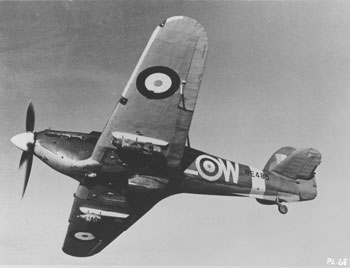 The
newly formed
175
Squadron
had not, at the time of the
accident, undertaken any
operational sorties. The Hurricane
IIB ground attack aircraft shown
here (left) was a sister
aircraft to the one flown by
William McLachlan and bears an
adjacent airframe number. It
almost certainly took part in the
Imber exercise on Monday April
13th (although without the bomb
load shown in the photograph). Its
fate was to be lost in the
Channel, together with its
20-year-old R.C.A.F. pilot,
Flight
Sergeant Bricker Forman,
during the Squadron's first
operational mission on the
following Thursday, April 16th. The
newly formed
175
Squadron
had not, at the time of the
accident, undertaken any
operational sorties. The Hurricane
IIB ground attack aircraft shown
here (left) was a sister
aircraft to the one flown by
William McLachlan and bears an
adjacent airframe number. It
almost certainly took part in the
Imber exercise on Monday April
13th (although without the bomb
load shown in the photograph). Its
fate was to be lost in the
Channel, together with its
20-year-old R.C.A.F. pilot,
Flight
Sergeant Bricker Forman,
during the Squadron's first
operational mission on the
following Thursday, April 16th.
The exercise
was repeated a few days afterwards in the
presence of Winston Churchill and General
George Marshall. It passed without mishap.
One must assume that 175 Squadron took no
part in the repeat.
It is a relief
to hear that in the course of the Inquest
the Coroner expressed his sympathy to this
unfortunate young man, William McLachlan.
We can only hope that it was of some
consolation to him for his part in the
tragedy.
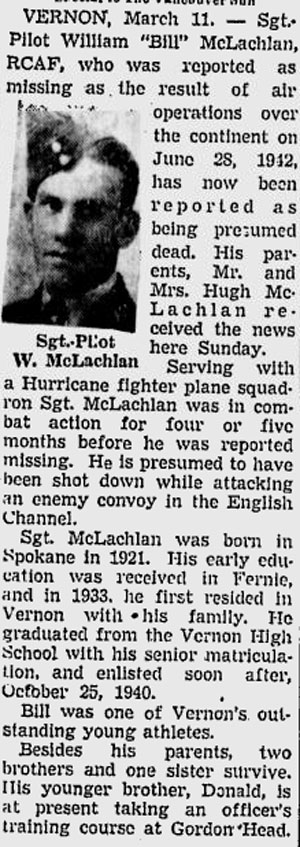
The
inquest at Warminster at which
William McLachlan was present and
gave evidence took place on Friday
26th June. Afterwards William
McLachlan returned to his unit at
RAF
Warmwell,
near
Weymouth
in Dorset. Very shortly
afterwards, during the night of
Sunday/Monday, 28/29th June, he
and at least one other member of
his Hurricane squadron took off to
attack enemy shipping between
Alderney
and the French coast. When the
flight returned to base he was
found to be missing, presumed shot
down over the sea by a ship's
anti-aircraft fire. His body was
never recovered and the only
formal commemoration of his loss
is on the
Runnymede Memorial
in Surrey.
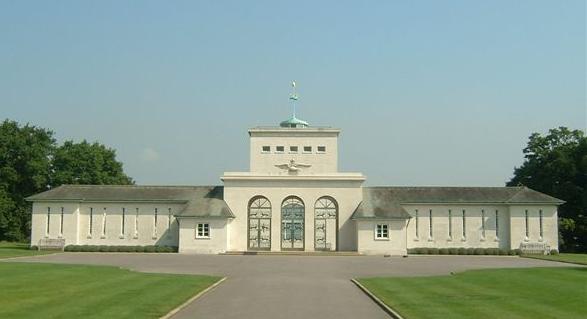
It took a long
time for his death to be confirmed and his
parents to receive formal confirmation.
This (right) is the report in a Canadian
newspaper.
FOOTNOTE
Later in the war, his parents would lose
another son, Donald, mentioned in the
newspaper cutting.
Lt. Donald Hugh
McLachlan of the
Seaforth Highlanders of
Canada died on 23rd May 1944 at
Monte
Cassino.
Perhaps it is appropriate
for us to remember, as we pursue our
mainly safe and comfortable 21st century
lives, the sacrifices made by a family
such as the McLachlans in the cause of
freedom and justice.
|
|
The tragedy, and the loss of individuals, has
been commemorated in different ways:
COMMEMORATION
As a result
of the creditable efforts of the
Wiltshire Historical Military
Society,
a memorial plaque was unveiled in
Warminster Church
on the 70th anniversary of the
tragedy, in 2012.
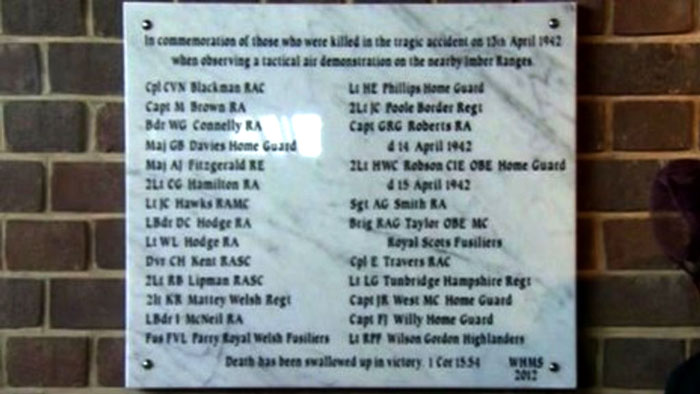
This lists the victims of the
incident who lost their lives. It includes
the names of five Home Guard officers, as
follows:
Maj. G.B.
Davies
(aged 58) - 8th Hampshire (Avon
Valley) Battn.
Lt. H.E. Phillips
7th Wiltshire (Salisbury) Battn.
2/Lt. M.W.B. Robson, C.I.E.,
O.B.E.
5th Hampshire (Winchester) Battn.
(late Lt.-Col., Indian Army)
Capt. J.R. West, M.C.
(aged 47) - 5th Dorset (Weymouth)
Battn.
Capt. F.J. Willy
(aged 55) - 3rd Dorset (Poole)
Battn. |
And to that list, we can now
add:
Lt. G.G.
Cates
(aged 43) 5th Warwickshire (Solihull)
Battn.
|
(Omission of the name of Lt.
Cates from the Warminster memorial
is probably the result of
inadequate contemporary records
and the timing of his death from
wounds several days later. Perhaps, some
time in the future, an addition might be
made so that his sacrifice is permanently
recorded in Warminster
Garrison Church for visitors to see and honour).
UPDATE - January 2018
The omision of the name of
Gerald Cates from the
memorial plaque has not
gone unnoticed elsewhere.
The Wiltshire Historical
Society have arranged for
his name (and that of
another casualty,
Capt. Peregrine
Makepeace Matson, 2nd
Field Regt. R.A.),
to be added to the
memorial. The ceremony has
been arranged for Friday
April 13th 2018 and
the unveiling will be
carried out by
Lt. Gen. Sir Roderick
Cordy-Simpson.
(Grateful
acknowledgement
to John
Pidgeon for this
information) |
Lt. Gerald Cates now rests in the
Robin Hood Cemetery, Solihull:
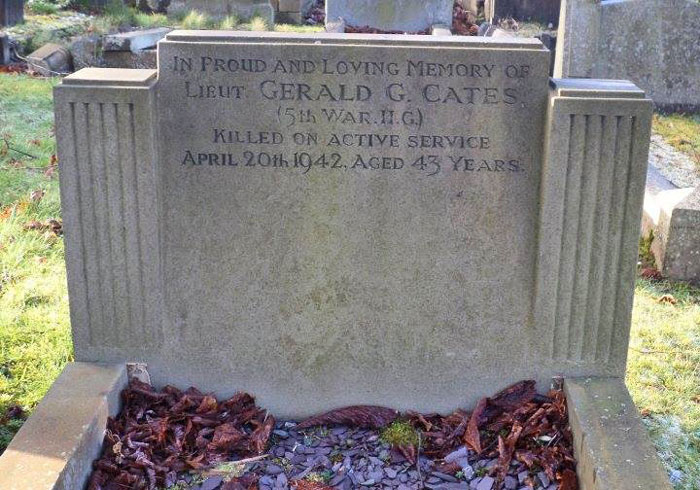
|
|
In Memory of
Lt.
Gerald George Cates - 5th Warks (Solihull)
Battn.
of
his
Home Guard comrades who died in the same
incident:
Maj. G.B.
Davies, Lt. H.E. Phillips, Lt. M.W.B.
Robson,
Capt. J.R. West and Capt. F.J.
Willy
of
Flight
Sergeant William McLachlan - R.C.A.F. 175 Sqdn.
and of
all those
whose lives were affected by the
Imberdown tragedy of 13th April 1942
|
Grateful acknowledgement
is made to the following sources of
information:
Matt Felkin and his
Wartime Birmingham and the Blitz Facebook page
(for the original
cutting);
Mr Danny
Howell (for the plaque image and other
information); Maggie Laity (for the headstone
image); the Commonwealth War Graves
Commission; The Times Archive; the Leicester
Mercury; Lives of the First World War;
findagrave.com; "After The Battle" magazine;
rcaf-arc.forces.gc.ca
Source of
information for further research
"After The Battle" magazine, Issue 49, 1986.
(Back copies still available from
the publisher).
Plaque image © Danny Howell 2016
Headstone image © Maggie Laity 2016
x145 - January 2017, updated January 2018
|






